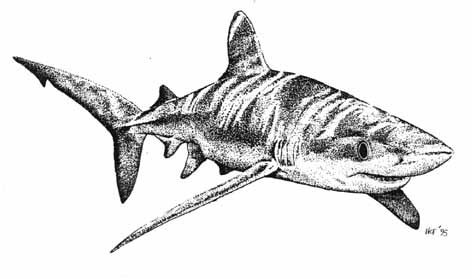Blue Shark (Prionace glauca)

(Linnaeus, 1758).
| Fr: |
Requin bleu; Peau-bleue |
| Sp: |
Tintorera (Catalunya); Arlequi
(Valencia) |
| It: |
Verdesca; Verdun (Liguria); Musiedde
(Taranto); Virdiscu (Sicily) |
| Ma: |
Huta kahla |
Diagnosis
An unmistakable, gracefully-proportioned, slender-bodied
shark with a long snout and no interdorsal ridge. Eyes large;
pectoral fins long and rather slim, with curved apexes; 1st dorsal
fin rather small and with a curved apex, situated well behind the
pectoral fins with its midpoint nearer to the pelvic fin origins.
Low keels present on caudal peduncle; anal fin posterior margin is
deeply notched. Papillose gill-rakers present and are unique amongst
carcharhinids. Upper jaw teeth noticeably obliquely curved and
triangular with serrated margins. Colour dorsally vivid
cobalt blue, shading to metallic mid-blue on the flanks and white
ventrally.
Size
To about 380cm but commonly from 50 to 250cm in the region; size
at birth 35 to 44 cm.
Status and Distribution
N.E. Atlantic: Common and cosmopolitan south of Lat. 50N
(i.e, from S.W. England and S. Ireland southwards). Northerly limit
to range is Icelandic and North Norwegian coasts, where these sharks
may stray as sporadic outliers during particularly warm
summers.
Mediterranean Sea: Common; entire Mediterranean,
including Adriatic and Sea of Marmara but not Black Sea.
Biology
Typically an offshore, pelagic species from the surface down to
at least 150m; highly nomadic, undertaking journeys between and
across the great ocean basins, including inter-equatorial
movements. Occupies sea-temperatures of 7 to 16C, sometimes up
to 25C and may swim in the deeper, isothermal Southern Mediterranean
waters during the high summer. Blue sharks also make inshore
incursions, particularly at night; juveniles may also inhabit waters
less than 50m deep, such as off Portugal and within Northern
Adriatic waters (both areas are nursery-zonse for this species)
during the summer months. This species also occurs nearshore off
Mediterranean islands adjacent to deep water (e.g., Isola Ponza and
Aeolian Islands in the Tyrrhenian Sea). Blue sharks are
graceful, efficient slow cruisers, typically averaging 0.8km/h
groundspeed over their long-distance meandering; often seen near the
surface but capable of deep, gliding dives (using their long
pectoral fins for minimum effort in controlling descent) in search
of deep-ranging or vertically-migrating prey such as squid.
They will often congregate in great numbers at food-sources (for
example, floating whale carcasses) but generally are rather
solitary. Typical prey includes scombroids such as mackerel,
scad, bonito and bullet tuna; clupeids includings herring and
sardines; jacks, garfish (especially in the Adriatic) and other
pelagic schooling fish; occasionally demersal, benthic or littoral
fish prey (e.g., thick-lipped mullet, conger eels and
flatfish); pelagic flying-fish eggs (apparently a very common
food-item in Adriatic specimens); squid and cuttlefish (also
important regional prey); crustaceans; an occasional
scavenger upon mammalian remains (dolphins, whales and porpoises)
and even consumes seabirds (a gull was recently found inside an
Adriatic specimen), although these may be attacked only
post-mortem. The writer and Dr Irene Bianchi have observed
neonatal blue sharks to actively pursue similarly-sized specimens of
garfish, Belone belone, at the surface but without achieving
contact; possibly motivated through intraspecific competition for
small fish baits. Commonly observed to follow ships in Mediterranean
waters, quite possibly for great distances (the writer was told of
two blue sharks that diligently followed a ship non-stop from Cyprus
to Malta, feeding voraciously on discarded kitchen garbage, only
then to be hooked and killed by the crew!). Geographical
sexual segregation is common in these sharks; the majority of
specimens taken off Great Britain being females whilst off Long
Island, New York, male sharks predominate. Litter sizes
are large, up to 135 pups but highly variable; gestation period 9-12
months; maturing 5-year old females can store sperm in their
shell glands and defer fertilization until in their 6th year; young
are born to females of 7 years, with neonatal specimens common in
Mediterranean waters from late May to July. Limited tagging
returns from an ongoing north Adriatic study co-ordinated by Dr.
Irene Bianchi and Big Game Italia (pers. comm.) suggests movement of
neonates from the Po Delta region to both the Eastern and
Western-Central Mediterranean, but no recaptures are yet known from
Atlantic waters. It is possible that these sharks only exit
the Mediterranean when nearing adulthood, but further tag-return
data will confirm or nullify this thesis. Females mature at
about 221cm; males between 182 and 281cm TL.
The Shark Trust, 36 Kingfisher Court, Hambridge Road, Newbury, Berkshire, RG14 5SJ, UK.
Tel(+44) 01635 551150, Fax(+44) 01635
550230
|